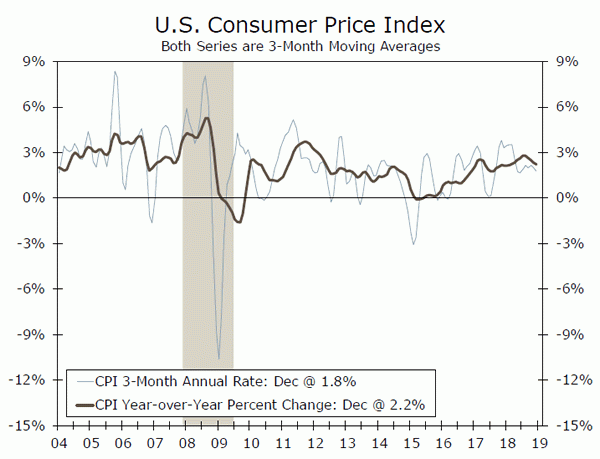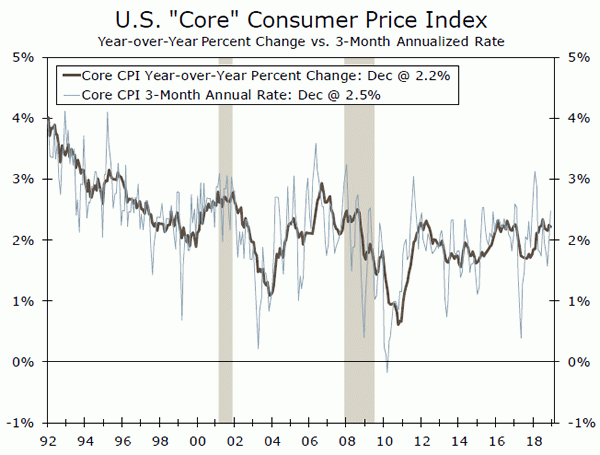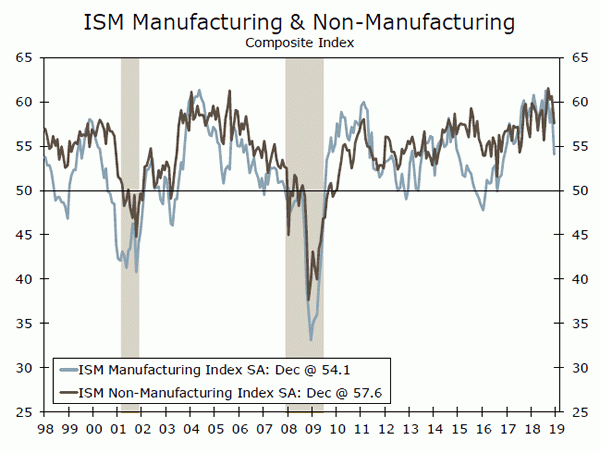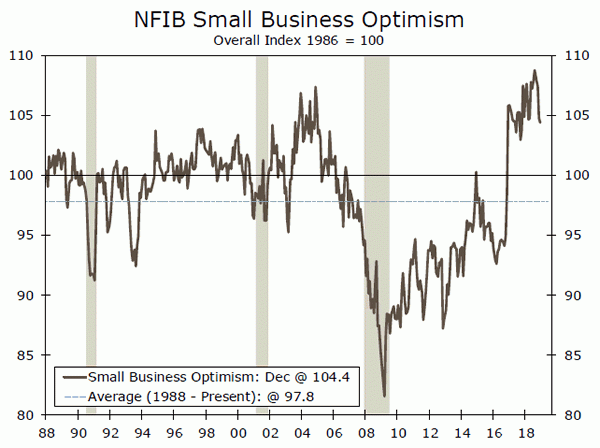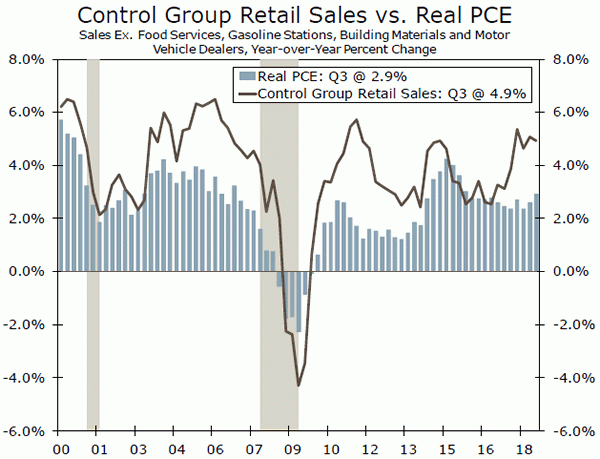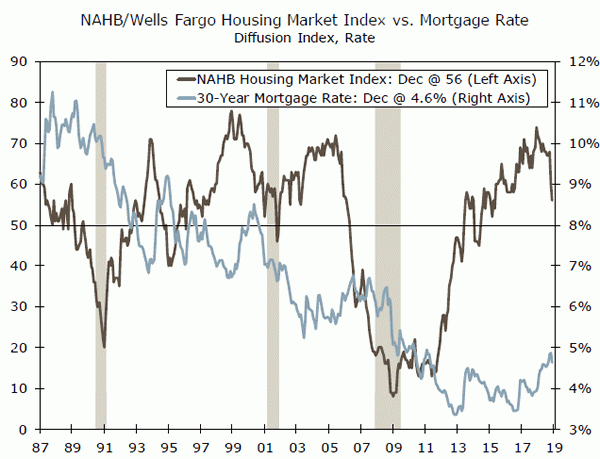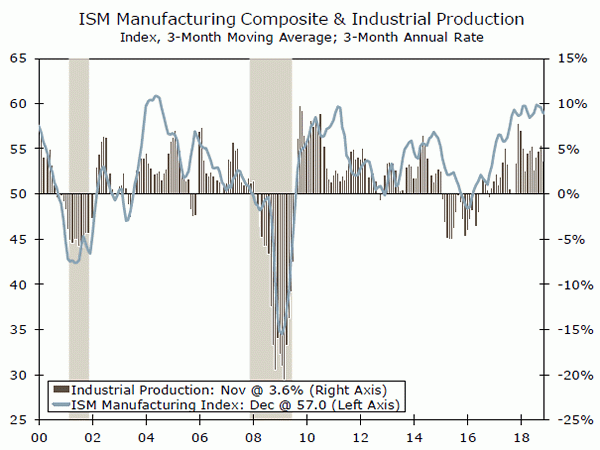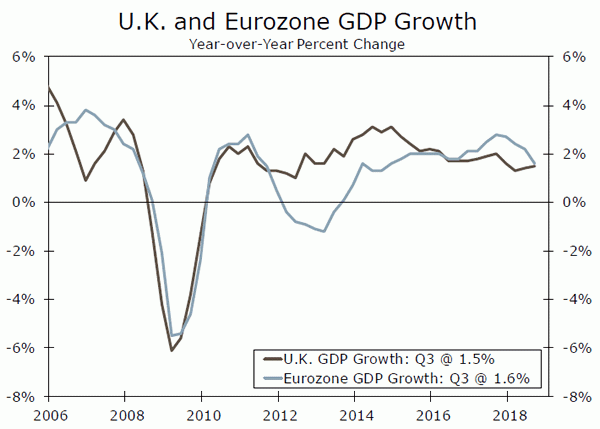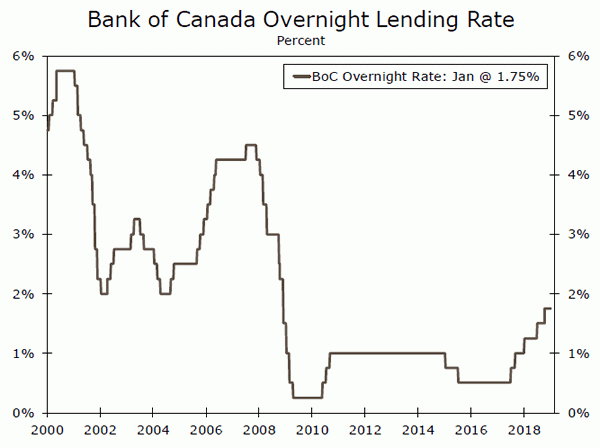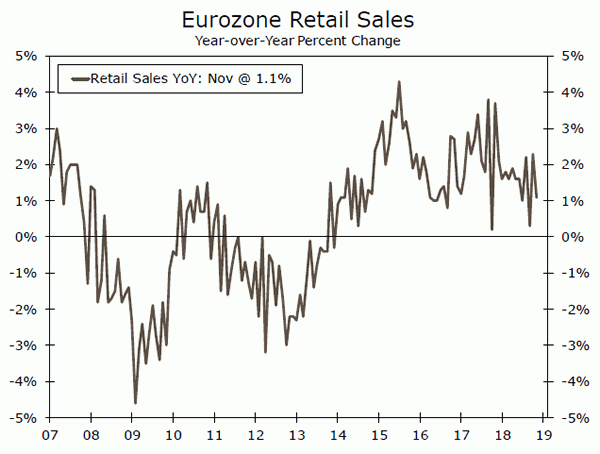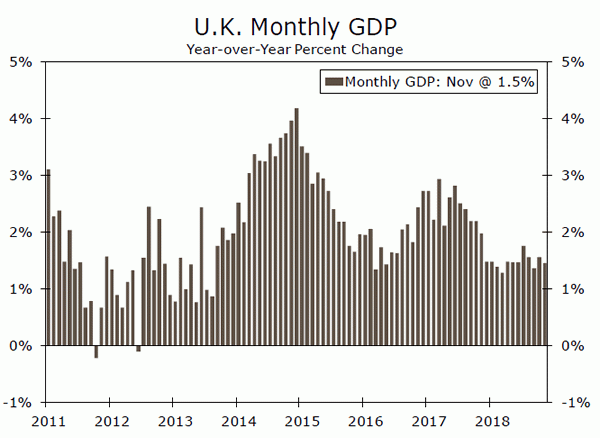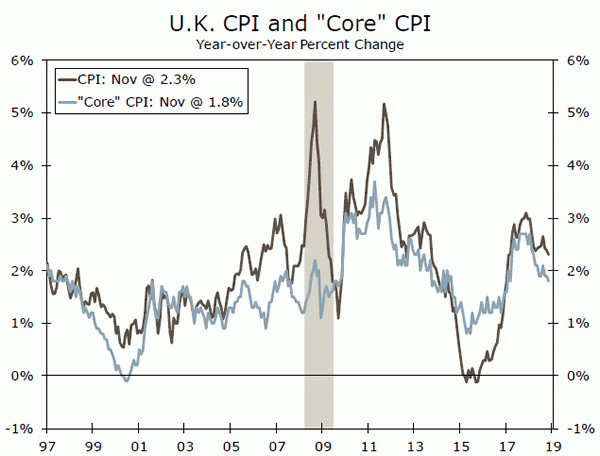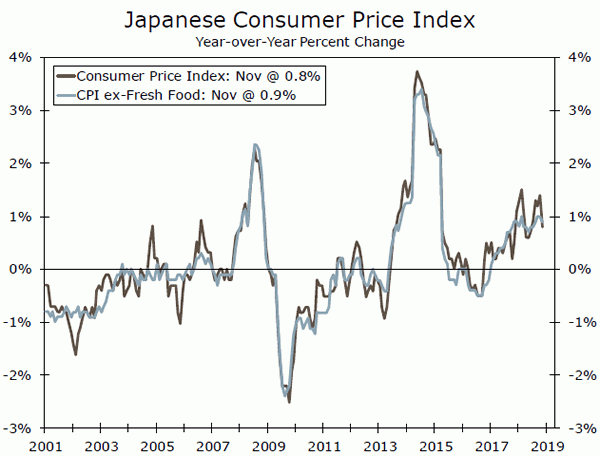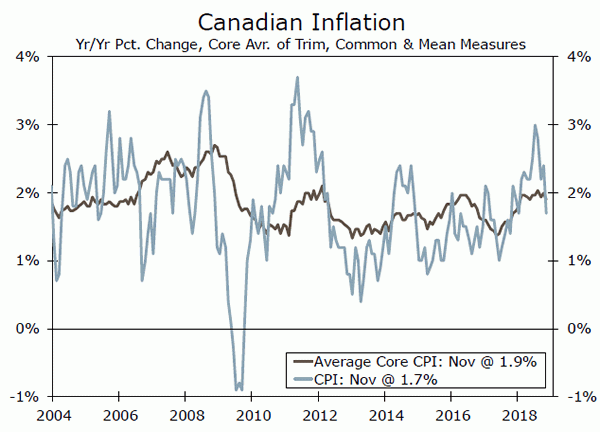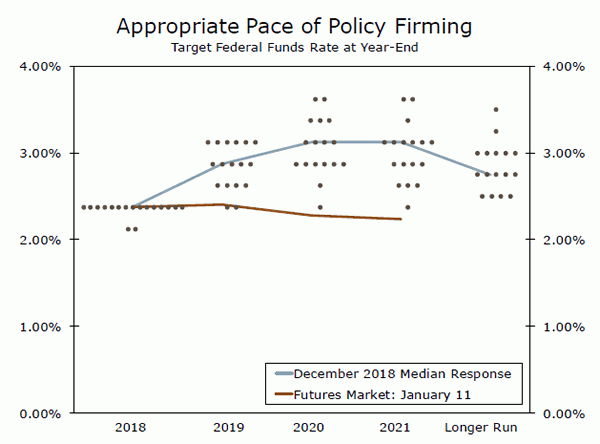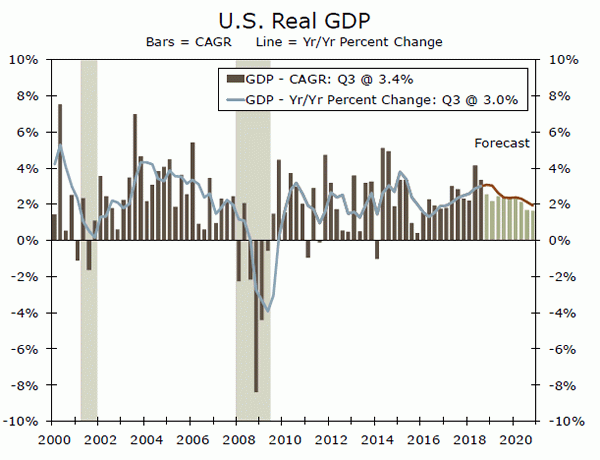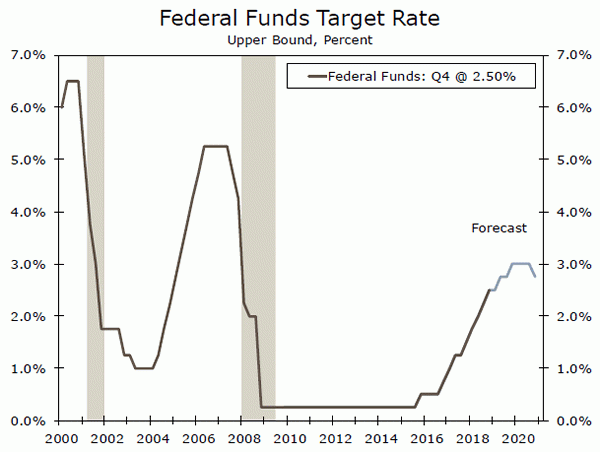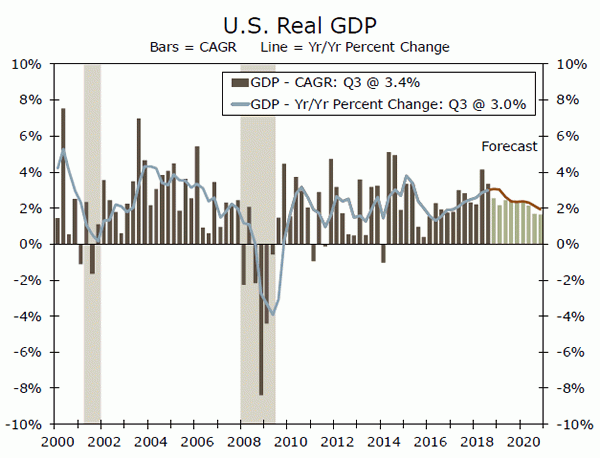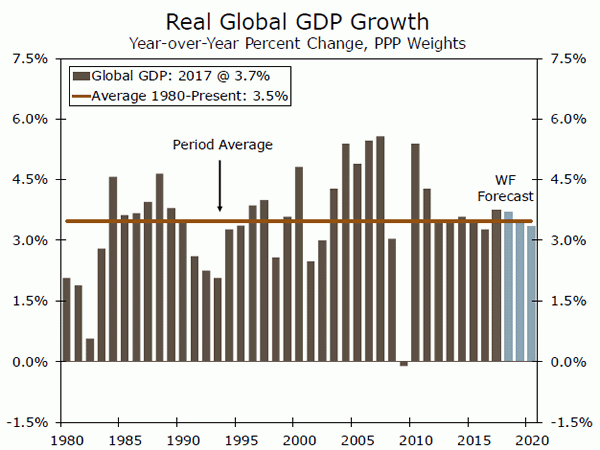U.S. Review
All We Need Is A Little Patience
- Fed officials this week reemphasized that they would exercise patience, making a pause in rate hikes in March more likely.
- The CPI fell 0.1% during December owed to lower energy prices. Core CPI increased 0.2% and is up 2.2% year-to-year.
- The ISM non-manufacturing index fell from 60.7 in November to a still-elevated 57.6 in December. New orders rose to 62.7.
- The NFIB Small Business Optimism Index fell to 104.4 in December, the fourth consecutive drop.
- The federal government remains partially shut down, leading to numerous data reports being postponed this week.
All We Need Is A Little Patience
The Fed appears increasingly likely to hit the “pause” button in March amid financial market volatility, trade uncertainty and an overall moderation in economic growth. In a speech this week, Fed Chairman Powell reemphasized that the Fed would exercise patience and watch the economic data carefully, a sentiment that was echoed by Fed Vice Chairman Clarida. Given a strong labor market and contained inflation, we still expect two hikes from the Fed to occur in 2019. However, the Fed has clearly struck a more dovish tone recently making a pause in March more likely.
Some uncertainty may be brewing as a result of the continued government shutdown. The inability of Congress and the Trump Administration to reach an agreement on all 2019 appropriation bills has led to a partial government shutdown since December 22. If no agreement is reached by January 14, it will mark the longest federal government closure since the 21-day shutdown of 1995-1996. At present, we do not view the shutdown as having a significant negative effect on overall economic growth. However, it has substantially slowed down the stream of economic data that is compiled and released by government agencies that receive federal funding, notably the U.S. Department of Commerce, which houses both the Census Bureau and Bureau of Economic Analysis. As a result, reports on factory orders, the trade balance and the Treasury monthly budget statement were all postponed this week.
Not every agency has been shuttered, however, as roughly 75% of federal agencies had already had funding approved prior to closure. The Bureau of Labor Statistics, which is a component agency of the fully funded Department of Labor, has remained open and released the latest CPI data for December. The report revealed that overall inflation remains in check, as the overall index fell 0.1% during the month, mostly owed to a 3.5% drop in energy prices. Given lower oil prices, the energy component will continue to be a drag on the overall index in coming months. Meanwhile, core inflation continues to gradually edge higher. The core index, which excludes energy and food, increased 0.2% during the month is up 2.2% over the past year (top chart). Recent firming in core inflation is primarily a result of increases in shelter costs and medical care services, which rose 0.3% and 0.4%, respectively, in December.
Meanwhile, weakness on the production side of the economy arising from the trade dispute appears to be confined to the factory sector. The ISM non-manufacturing index fell from 60.7 in November to a still-elevated 57.6 in December (middle chart), however the falloff was somewhat less dramatic than what occurred in the manufacturing index during the month. In contrast to its manufacturing counterpart, the new orders component of the services index edged higher to a six-month high of 62.7, which indicates that the service sector is poised to expand at a solid rate.
The NFIB Small Business Optimism Index also fell slightly, the fourth consecutive monthly decline (bottom chart). Most of the pullback came from the share of business owners expecting the economy to improve over the next six months, likely a result of financial market volatility that has plagued Wall Street lately.
U.S. Outlook
Retail Sales • Wednesday
Despite recent worries of slower domestic growth, the consumer sector looks poised to post another solid quarter to end the year. A recent indication of strength was November retail sales. Overall retail sales were held back by price-related declines at gasoline stations, something we expect to continue in December. The upside here is that smaller gas outlays frees up more money for other items. Control group sales, a proxy for personal consumption expenditures (PCE), were up 0.9%. This was the strongest monthly increase for 2018 so far, and points to another strong print for PCE in Q4.
November was the first month for holiday related spending and suggests we are on track to reach our forecast of 4.5% holiday spending growth over last year. The December retail sales report is slotted for release next week by the U.S. Department of Commerce. But, with the partial government shutdown impacting the release of many domestic indicators, retail sales looks to be delayed as well.
Previous: 0.2% Wells Fargo: 0.4% Consensus: 0.2% (Month-over-Month)
NAHB Housing Market Index • Wednesday
After plunging eight points in November, the NAHB Housing Market Index fell four points to 56 in December. The overall level of builders’ confidence at its current level is still indicative of a majority of builders seeing current conditions as good rather than poor. But, having fallen 12 points over the past two months, the overall index sits at its lowest level since May 2015.
Higher mortgage rates have likely been partly to blame for decreased confidence among builders. The more recent decline in mortgage rates, however, may provide some support to the housing market, which has essentially stalled this past year. The Federal Reserve is likely taking note of builders’ confidence, as the housing market is one of the primary transmission mechanisms for monetary policy. Lower overall inflation will likely limit the extent of further policy tightening. We look for the Fed to raise rates 50 bps this year, which could lend some support to the housing sector.
Previous: 56 Consensus: 56
Industrial Production • Friday
Due to its more volatile components, industrial production (IP) rose 0.6% in November. Utilities output contributed much of the gain, as colder-than-usual temperatures gripped much of the country. Slower global growth and booming petroleum supply in the United States led to a sharp decline in oil prices in Q4. That sharp drop in oil, however, did not hold back mining output in November, which was up 1.7% over the month and a whopping 13.2% from a year ago.
Manufacturing output, on the other hand, was flat over the month. More recent survey data, such as the ISM manufacturing new orders component falling 11 points to 51.1 in December, indicate some further slowing. We expect IP to rise 0.3% in December. Despite volatility in financial markets and worries of an imminent slowdown, a strong print in December IP would signal the industrial sector remains stable. A weaker print, on the other hand, may further stoke fears surrounding ongoing trade tensions and Fed policy.
Previous: 0.6% Wells Fargo: 0.3% Consensus: 0.3% (Month-over-Month)
Global Review
Slow Growth, Slower Central Banks
- The Bank of Canada (BoC) held its policy interest rate at 1.75% this week, as expected, and said lower oil prices would depress growth over the next couple of quarters. However, the central bank sees a return to above trend growth over the medium term, and we still expect the BoC to raise rates later this year.
- Eurozone data were a mixed bag this week, with some stability on the services side but softness in the industrial sector. We do not view the figures as weak enough to signal an imminent recession, but they could be soft enough to slow Eurozone monetary tightening. In the U.K., economic growth remained sluggish ahead of a key Brexit vote due next week.
Bank of Canada Not Ready to Hike Rates Yet
The Bank of Canada (BoC) held is latest monetary policy meeting this week, holding its benchmark policy interest rate steady at 1.75%, as we expected. Since late last year BoC policymaker comments have become less hawkish, with the central bank noting a sharp drop in oil prices and also that trade conflicts are weighing more heavily on global demand. Some of these dovish elements were also apparent in the BoC’s latest statement. The central bank sees the sharp drop in oil prices depressing growth in late 2018 and early 2019, contributing to some slack opening up within the economy. Outside of the oil sector, however, the economy is seen as performing more solidly, and, after a period of slow growth in the near term, the central bank sees Canada’s economy returning to an “above potential” growth rate over time. In a similar vein the BoC also indicated that policy interest rates would need to rise over time to achieve its inflation target, although with the exact path of monetary policy dependent on several economic and market factors. Overall we see both positives and negatives in the central bank’s monetary policy announcement, and maintain our outlook for two BoC rate hikes this year.
Eurozone Economy Flirting With Recession?
This week was marked by a mixed batch of Eurozone economic data. On the stronger side, Eurozone November retail sales were solid, rising 0.6% month-over-month, matching the October gain, while unemployment also fell further in November. However, other economic figures were mostly consistent with a generally subdued Eurozone growth trend. German industrial output unexpectedly declined 1.9% month-over-month and French, Italian and Spanish industrial output all declined. In addition, Eurozone December economic sentiment fell to 107.3, a 12th straight fall. The decline in German output in particular raised the specter of whether the Eurozone economy is on the verge of falling into recession. In our view there appears to be enough solidity in the consumer sector, and momentum in the overall economy, to avoid a recession at this time. That said, we do expect the period of subdued Eurozone economic activity to persist further and, as a result, see a slower return to zero interest rates than previously expected by the European Central Bank.
U.K.: Sluggish Economy, Uncertain Outlook
This week’s U.K. data show signs of a potential moderation in economic growth late last year. November GDP rose 0.2% monthover- month, a slight increase from October. Service sector output was a bit firmer, rising 0.3%, but industrial output declined 0.4% on the month. After U.K. GDP was surprisingly strong in Q3, with a gain of 0.6% quarter-over-quarter (not annualized), the consensus slowdown is for some slowing in GDP growth in Q4 to 0.3%.
One factor that is likely contributing to sluggish growth is the U.K.’s approaching exit from the European Union and the associated uncertainty. A U.K. Parliamentary vote on PM May’s Brexit deal is scheduled next week, but is widely expected to be rejected. For the time being, slow U.K. growth and an uncertain outlook is likely to continue.
Global Outlook
U.K. CPI • Wednesday
Consumer price inflation in the United Kingdom has moved lower in recent months, a trend that likely continued in December. Given the drop in oil prices in recent months, we expect headline CPI inflation eased further to 2.2% year-over-year. Despite slower price outcomes recently, it is possible that inflationary pressures could rebuild over the medium term, with unemployment low and wage growth accelerating in recent months. That said, a near-term Bank of England rate hike seems unlikely with growth subdued, and until Brexit uncertainties have lifted and the nature of the future U.K./European trading relationship becomes clearer.
Separately and also on the consumer front, December retail sales are also released next week. Sales were particularly strong in November, with a rise of 1.4% month-over-month, and some payback is expected in December, with the consensus forecast for a 0.8% decline.
Previous: 2.3% Wells Fargo: 2.2% Consensus: 2.1% (Year-over-Year)
Japan CPI • Friday
Inflation pressures in Japan remain underwhelming, with the November CPI rising 0.8% year-over-year and the CPI excluding fresh food rising 0.9%, both well short of the Bank of Japan’s 2% inflation goal. For December, given a decline in energy prices, we expect headline inflation to slow noticeably to just 0.4%, while core inflation pressures should remain relatively steady. While we believe the Bank of Japan may take a tentative step towards monetary policy normalization this year, the low inflation readings suggest that may be at best a “one-and-done” move from the central bank.
That is particularly the case given relatively sluggish Japanese economic growth. The November tertiary industry index (a proxy for service sector output) is forecast to fall 0.5% month-over-month, after a large October gain. However, November core private machinery orders are expected to rise 3% month-over-month, hinting at more resilience in capital spending and industrial activity.
Previous: 0.8% Wells Fargo: 0.4% Consensus: 0.3% (Year-over-Year)
Canada CPI • Friday
Canadian inflation has slowed noticeably in recent months, and that trend appears likely to have continued in December. Given the further decline in oil prices, we expect headline CPI to slow to 1.5% year-over-year, which would be the smallest increase since mid-2017. Meanwhile, the Bank of Canada’s (BoC) various measures of core inflation remain close to 2%, the midpoint of the central bank’s inflation target range.
Lower oil prices are of course also relevant for the Canadian economic outlook, while we also observe that wage growth has slowed noticeably over the past several months. Against this backdrop, the BoC held its policy interest rate steady at 1.75% at its monetary policy meeting this week and appears comfortable with an unchanged policy stance for the time being, although we do expect the BoC to tighten further if growth and oil prices recover.
Previous: 1.7% Wells Fargo: 1.5% Consensus: 1.7% (Year-over-Year)
Point of View
Interest Rate Watch
A Little More Patience at the Fed
The minutes of the December FOMC meeting reinforced the notion that the Federal Reserve is likely to be more patient in raising interest rates in coming months. While the decision to raise the federal funds rate by a quarter percentage point in December was unanimous, there was considerable debate among FOMC board members about whether or not the Fed needed to raise rates. Absent the criticism from the administration the Fed might have been even more inclined to have left rates unchanged in December.
As it is, the federal funds rate is now close to what most FOMC members feel is a neutral level, where interest rates are no longer stimulating but not necessarily restraining growth. While the whole notion of a neutral rate is somewhat debatable and extremely hard to approximate when the Fed is also reducing its balance sheet and had unnerved the financial markets with its previous hawkish rhetoric, the financial markets now appear to feel assured the Fed will remain on hold for the next few months.
The financial markets seem to have an exaggerated sense of the Fed’s intentions, expecting it to remain on hold through all of 2019 and to cut rates a quarter point in 2020. This scenario requires a more pessimistic view of the economy than we think likely. We have slightly reduced our forecast for growth and inflation but still see real GDP rising 2.6% this year and 2.2% in in 2020. Growth will be slightly slower on a fourth quarter-to-fourth quarter basis but should still be strong enough to nudge the unemployment rate lower and push wages higher. We still see the Fed hiking rates twice this year, in June and December.
The key areas to watch are business fixed investment and manufacturing in general. If the damage to credit conditions proves significant enough to throttle back business fixed investment and hiring, then the Fed’s pause may prove more lasting. Wall Street appears to be much more worried about the fallout from this past fall’s stock market selloff and tightening in credit conditions than Main Street. We look for job growth and consumer spending to hold up relatively well.
Credit Market Insights
Where’s the Issue?
There were zero high yield bonds issued in December, the first month since 2008 that not a single company below investment grade raised money in public debt markets. With concerns of a more pronounced slowdown mounting, the fourth quarter of 2018 saw a surge in equity market volatility and credit spreads. The Bloomberg Barclays high yield average spread index rose more than 200 bps in just three months as risk preferences shifted towards safer assets. Facing sharply higher financing costs and greater uncertainty, lower rated companies retreated from public markets. What impact do higher corporate bond yields have on the broader economy?
For one, a higher cost of capital lowers the net present value of future projects, rendering companies less likely to embark on those project and initiate new capital spending, all else equal. In the December NFIB survey, plans to increase capex over the next six months fell four points to the lowest level since 2016. Moreover, the new orders component of the December ISM survey fell 11 points. The final month of the year was further evidence of the deleterious effect tighter financial conditions are having on business fixed investment.
Spreads have retreated a bit over the past week, however, as the December FOMC meeting minutes signaled the committee’s shift to a decidedly more dovish tone. The FOMC appears committed to monitoring financial conditions before tightening monetary policy further.
Topic of the Week
Where Have All the Good Times Gone?
This week we released our January Monthly Economic Outlook and Monthly Macro Manual, where we highlight key changes to our economic forecasts and views on the state of the economy in the month ahead. Financial market jitters to end 2018 led market participants to question if the domestic economy is poised for a broader slowdown in coming months. In our view, while there have been signs of slowing economic growth, many of these trends are driven by policy changes, rather than fundamental weakness in the U.S. economy. On the domestic side of the equation, tighter Fed policy looks to be a drag on the housing market in terms of higher mortgage rates, while retaliatory Chinese tariffs on U.S. goods have weighed on exports in recent months.
But on the bright side, income growth continues to remain solid, while lower oil prices should support further gains in consumer spending. Although we look for the recent sharp drop in oil prices to weigh on energy sector investment in the near term, its impact will likely not be nearly as pronounced as during the similar energyrelated slowdown of 2015-2016. We still look for real GDP to rise at a solid 2.5% annualized rate in Q4 (top chart).
We acknowledge that the recent tightening in financial conditions and slower growth on the horizon will likely have an effect on Fed policy. While we still look for the Fed to raise rates twice in 2019, we have pushed back the timing to June and December, given recent developments in financial markets, growth concerns and the Fed’s desire to become more data dependent.
On the international front, a similar set of concerns exists surrounding global growth prospects, as several key economies registered slower GDP growth in Q3, namely the Eurozone and China. At the same time, global political developments remain in focus, with a key Brexit vote scheduled for next week and U.S./China trade talks ongoing. Looking past these uncertainties, we still look for the global economy to expand at a solid pace in 2019 near its long-run average of 3.5% (bottom chart).




